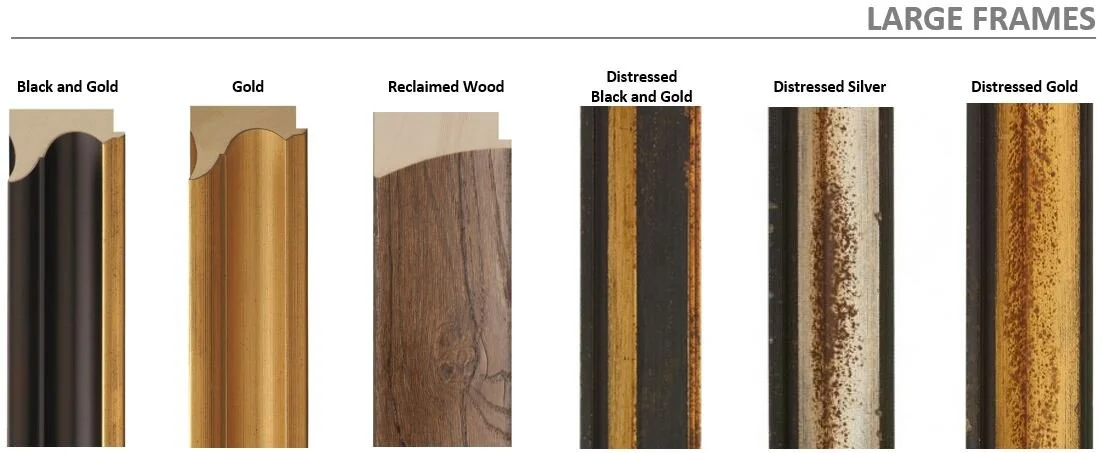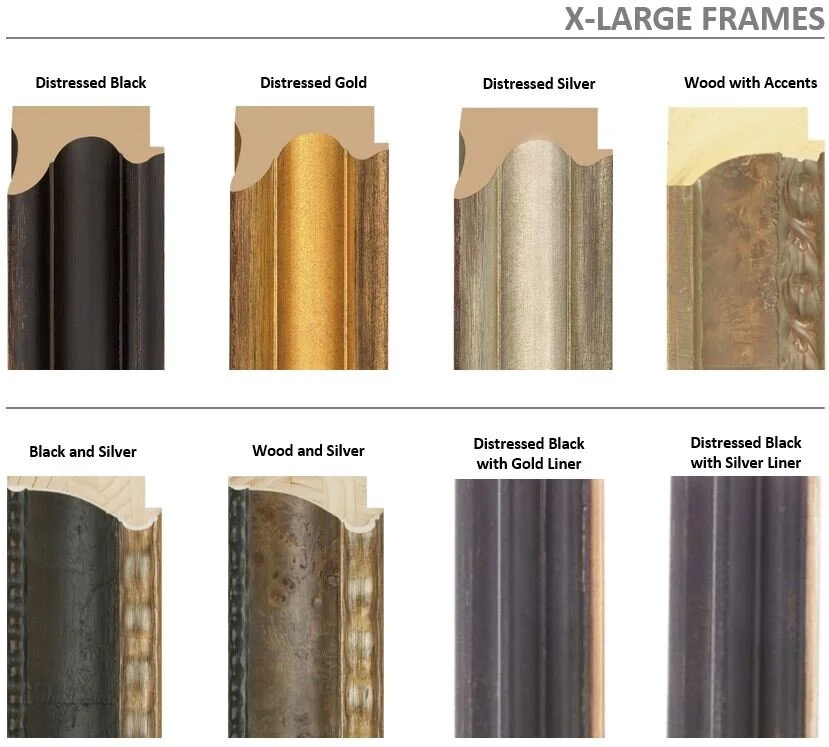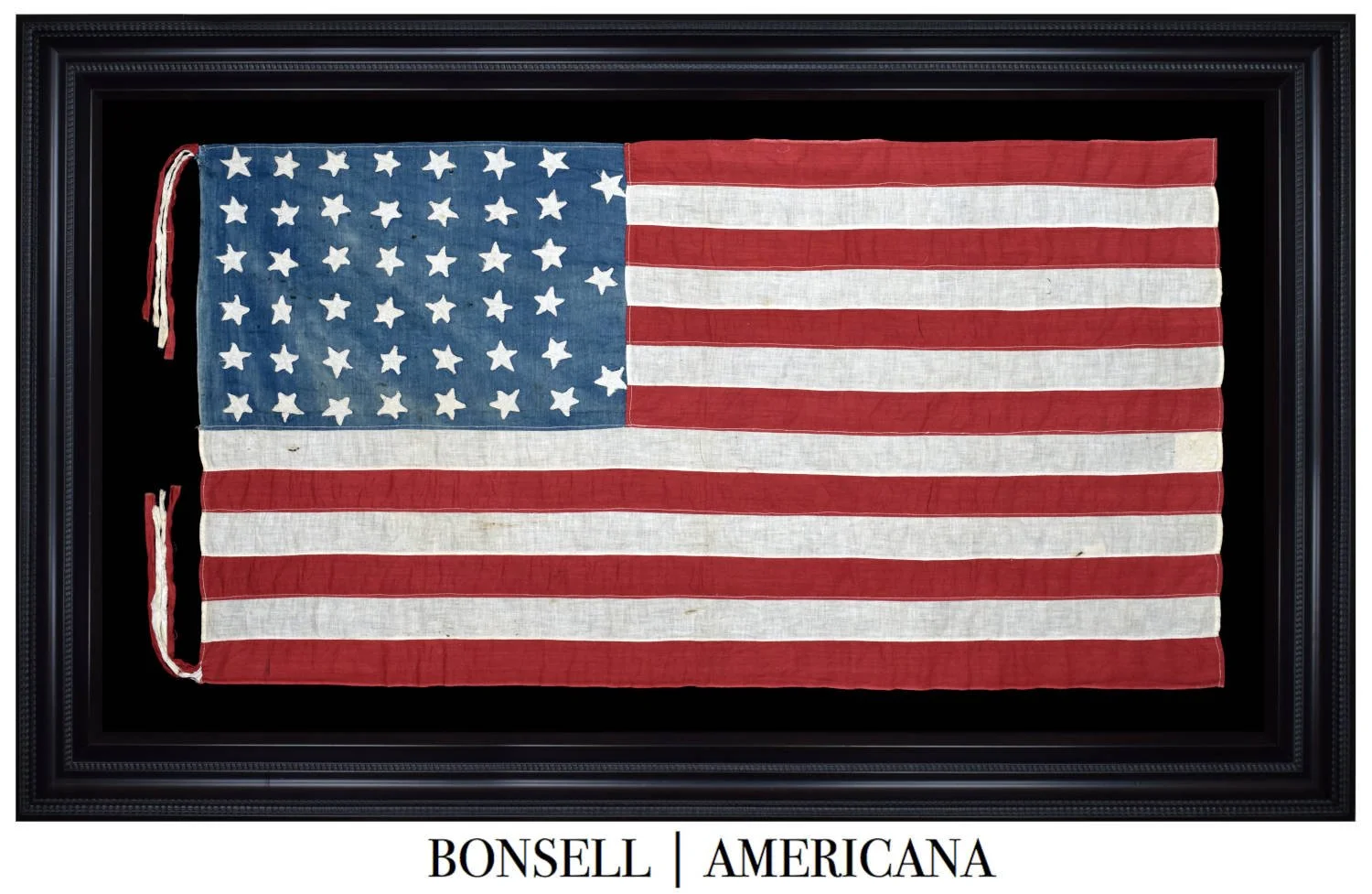Spectacular Antique Flag with 12 Stars | Likely Made to Recognize Missouri's Secession from the Union or to Commemorate North Carolina's Statehood | Circa 1860-1893
Spectacular Antique Flag with 12 Stars | Likely Made to Recognize Missouri's Secession from the Union or to Commemorate North Carolina's Statehood | Circa 1860-1893
Frame Size (H x L): 42.5” x 57”
Flag Size (H x L): 30.5” x 45”
Offered is a spectacular twelve-star antique flag. It is a homemade example and visually striking in every respect. But perhaps most striking of all, it has nineteen stripes—among the most that we have ever encountered on an antique flag—rather than the standard thirteen. In some cases, the number of stripes has a symbolic meaning. However, the nineteen stripes of this flag are probably either a function of it being made with scraps from other projects or with whatever material happened to be available to the maker.
The stars are in a 4-4-4 rectilinear pattern, and they are canted in various, random directions. They are made of cotton, sewn by hand with a running stitch and a whipstitch, and single-appliquéd. When applied in this manner, the stars are sewn to just one side of the canton, the canton is cut away from behind each star, and the canton is then hemmed around each star. By doing this, the single piece of cotton used for each star can be seen on both sides of the flag. This method is difficult to execute, but the upside is that it conserves material, reduces weight, and allows the flag to flow horizontally and visibly in the wind.
Single-appliquéd flags are highly desirable. They are much rarer than double-appliquéd flags. Only around 20% of the flags made during the 1860s are single-appliquéd; only around 10% of those in the 1870s are as such; and only around 1% of those in the 1890s are such. Additionally, the stars on single-appliquéd flags are attractive and folksy. In the case of this flag, its stars resemble star fish and are visually interesting.
The First Flag Act of 1777 specified that the flag should have stars, stripes, and a canton. However, it did not specify the proportions of the individual components, the proportions of the components relative to one another, the proportions of the overall height relative to the overall width, and the like. Such proportions were not specified until 1912. In the case of this flag, its stars and canton are unusually large, and the overall length of the flag is relatively short (i.e., the flag looks stocky).
The First Flag Act also specified that the flag should be red, white, and blue, but it did not specify the shades of these colors. The shades thereof were not specified until 1934. Thus, flags made therebetween often exhibit unusual colors. In the case of this flag, it red stripes and the blue canton are both particularly vibrant.
The cotton canton is handsewn to the striped cotton bunting, using both a running stitch and a whipstitch. The canton is a single piece of material, while the bunting is two separate pieces. The separate pieces are handsewn to one another using a running stitch.
THE TWELVE STARS
The number of stars on a flag is generally a function of how many states were in the Union at the time the flag was made. In general, the star count is a reliable way to determine a flag’s age. However, there are many exceptions to this general rule, including anticipatory flags, which are older than the official dates normally associated with their star counts; thirteen-star flags, common throughout our nation’s history; and flags with “extra stars” that were added at some point after their initial date of manufacture.
In the case of this flag, knowing with certainty what the maker intended with respect to the twelve stars is not possible. However, there are at least three reasonable explanations.
FIRST THEORY | EXCLUSIONARY FLAG
The first theory is that this an exclusionary flag with a star count that represents Missouri, the twelfth state accepted to the Confederacy (even though its acceptance thereto was in opposition to Missouri’s controlling, pro-Union government wing).
An exclusionary flag is one that is meant to exclude a portion of the United States, and that includes fewer than the official number of stars for a given time period. Despite President Lincoln’s pleas to avoid such a practice, there were Northern flags that excluded the stars representing the Southern states, and there were Southern flags that excluded the stars representing the Northern States. These latter flags are more specifically referred to as secession flags or Southern sympathy flags.
When Lincoln was elected president, the South Carolina legislature perceived him as a threat, knowing that he was an opponent to slavery and particularly its expansion. In response, delegates voted to remove South Carolina from the Union. Following its secession, Mississippi, Florida, Alabama, Georgia, Louisiana, and Texas followed suit, in this order, in a first wave. Shortly thereafter, following the Confederacy’s’ attack on Fort Sumter, Virginia, Arkansas, Tennessee, and North Carolina also followed suit, in this order, in a second wave. These waves occurred in sudden fashion. South Carolina’s secession occurred on December 20th, 1860 and North Carolina’s secession occurred, just months later, on May 20th, 1861.
Missouri was a border state and political powder keg. Southerners traveling up the Mississippi and Missouri Rivers settled the state, and many of them brought slaves with them. Northerners also entered the state in large numbers and held their own political views. Missouri became a state in 1821, following the Missouri compromise in 1820, in which Congress agreed that slavery would be legal in therein, but otherwise illegal north of the 36°30' latitude. As part of the compromise, Maine would enter the Union as a free state, so as to maintain the overall balance between free and slave states.
In 1854, the Kansas-Nebraska Act nullified the Missouri Compromise by permitting the Kansas and Nebraska territories to decide for themselves, by a vote, whether they would be free or slave states upon joining the Union. At this time, federal law decreed that slaves that physically enter a free state become free themselves. In view of this, Missouri slave holders were concerned that if Kansas became a free state, then the entire border between Missouri and Kansas would be a conduit for smuggling slaves to freedom via the Underground Railroad. Pro-slavery residents of Missouri saw this as a threat, while in contrast, anti-slavery residents of Kansas saw this as an opportunity. Violence ensued therebetween, each side hoping to influence how Kansas would enter the Union.
In 1860, outgoing Governor Robert Marcellus Stewart, who had northern leanings, proposed that Missouri remain part of the Union and militarily neutral, the only exception being that Missouri should protect its borders. In contrast, incoming Governor Claiborne Fox Jackson had southern leanings, and following his election, he promoted Missouri’s secession, planned to seize a federal arsenal in St. Louis, and conspired to divert money to Missouri’s troops. Following a series of conflicts between Missouri and the Union, Jackson and remnants of the elected state government were driven to the southern part of the state. They developed a shadow government and enacted an Ordinance in Secession. In response, the Confederate States of America accepted Missouri as the twelfth state thereof and gave it votes in the Confederate Congress. In other respects, the shadow government was essentially powerless (relative to the remaining portions of the actual government).
In parallel with the shadow government’s supposed secession, the actual government reconvened via the Missouri Constitutional Convention and declared the Missouri governor’s office to be vacant. It appointed Hamilton Rowan Gamble as the new governor, who agreed to provide troops to the Union Army. Under his leadership, 447 Missouri Regiments fought for the Union, including the 1st Missouri Volunteer Calvary Regiment, which fought continuously throughout the entire conflict.
In the case of this flag, the twelve stars may represent Missouri’s status as the twelfth state in the Confederacy, while its overall traditional layout may represent national patriotism or respect for the stars-and-stripes. Additionally, as discussed, Missouri had mixed loyalties, and subtle symbolism via flags was sometimes used as a means of communication in such states. On at least some occasions, unusual flags were made to mark secret meeting locations or to signal that aid is available with respect to a cause.
SECOND THEORY | COMMEMORATIVE FLAG
The second theory is that this is a commemorative flag with a star count that represents North Carolina, the twelfth state to join the Union.
In 1787, the colonies held a Constitutional Convention and drafted the US Constitution. In 1788, North Carolina voted on whether to accept or reject it. It did the latter, the basis being a fear that the national government would be too powerful and the states too week. In 1789, it voted again and accepted it. The second vote was successful, because the national leaders added the Bill of Rights to the Constitution, which promised to protect the rights of the people, thus alleviating at least some of the concerns associated with the first vote. Additionally, the second vote was successful, because the wealthy plantation owners in the northeastern portion—who supported the Constitution even in the first vote and who held the bulk of the political power—threatened to seceded, absent a successful second vote. North Carolina became a state on November 21st, 1789.
In the case of this flag, it may commemorate North Carolina’s admission to the Union. It would not date to 1789 or anywhere close thereto. Rather, it would date to North Carolina’s 75th anniversary in 1864 or its 100th anniversary in 1889—the most logical boundaries from an anniversary perspective in view of the flag’s materials, construction, and appearance. To at least a certain extent, flags made for such events were handsewn and homemade, and they were flown in various manners, particularly on front porches, store fronts, and buildings.
Along similar lines, this flag may have been displayed at the Centennial International Exposition in Philadelphia in 1876 or the World’s Columbian Exposition in Chicago in 1893, both of which were patriotic events and logical in view of the flag’s construction and appearance. That said, flags flown at such events were typically made of wool, almost certainly in the case of flags flown outdoors. As such, in the case of this cotton flag, its material suggests that it would have been used indoors. Further, flags flown at such events were typically professionally manufactured. Thus, in the case of this flag, its handsewn construction and folksiness suggest that it probably was not used at the Expositions or similar events.
Of the different places and times mentioned under this second theory, we believe that it would most likely have been used as a commemorative flag with respect to an anniversary and flown informally at a home or shop. Damage to this hoist suggest that this flag was used with some frequency outdoors, but presumably with protection from the elements, particularly water. Alternatively, this flag may have been moved indoors and outdoors, per the weather. Such movement would logically fit with what a homeowner or shop owner might do with respect to a standard upkeep regimen.
THIRD THEORY | NAVY ENSIGN
The third theory is that this is a navy ensign with a rare count of twelve stars. An ensign, or sometimes referred to as a boat flag, is a national flag that is flown on a boat or ship, typically on the stern of the vessel. In the 18th century and much of the 19th century, the US flag was primarily considered a maritime flag, and for this reason, the national flag used on land was the same as the one used at sea. Beginning in the 1850s (and perhaps earlier), the US Navy began utilizing thirteen-star flags, so that each star could be as large as possible and, thus, make the US flag easily identifiable at long distances upon the open seas. In 1916, the US Navy discontinued this custom and transitioned to incorporating a full star count.
Ninety-five percent of ensigns include thirteen stars. In contrast, the other five percent include a combination of twelve, fifteen, sixteen, twenty, and twenty-four stars, all of which are star counts that are discernible from a distance, easy to place, and easy to arrange in a manner that mimics traditional military based formats.
Due to the extreme environment that ensigns endure, they typically include grommets, gussets, heavy grade wool, and extra stitching. Further, most ensigns appear to be “long” versus other flags. This is so that the ensign is easy to identify without taking up too much vertical space on the ship, and so that after extended use, it can be repeatedly trimmed and hemmed to repair any damage that may occur.
With this backdrop in mind, in the case of this flag, its star count suggests that it may be an ensign, but its cotton construction suggests differently. Cotton absorbs water and is relatively weak; Wool sheds water and is relatively strong. It is possible that a sailor made this flag for use in a dry place on a ship, such as the pilot house. Ultimately, we believe that this third theory is worth mentioning in the spirit of a complete analysis, but we also believe that it is the least likely of the theories presented herein (i.e., 5% chance or less).
DATE OF MANUFACTURE
Prior to the Civil War, the military did not regularly carry flags, and Americans did not typically display them for patriotic purposes. Instead, as discussed above, most flags prior to the Civil War were used to mark ships and massive in scale. The surge in small flags for patriotic purposes began with the election of Lincoln and the onset of the Civil War. This was the first time in our history that private citizens began purchasing, making, and displaying flags. For this primary reason, it is much harder to find flags that predate the Civil War, and much easier to find flags that date thereto or thereafter. As a general rule, pre-Civil War flags account for only 1% of nineteenth century flags.
In view of this backdrop, and in view of the construction, materials, and appearance of this flag, we believe that it dates to 1860 or later. If the first theory is correct, this flag would date to 1861 or thereabout. If the second theory is correct, then this flag would likely date to between 1864 and 1893. Its construction, materials, and appearance suggest that this flag dates to 1890 or earlier. In totality, we conservatively believe that this flag dates to between 1860 and 1893.
Regardless of which of the above theories is correcting, finding nineteenth century twelve-star flags is exceedingly difficult. This is the first one we have handled. It is hard to imagine an example much better than the one offered herein. It is extraordinary in every respect.
Conservation Process: This flag was hand sewn to cotton fabric, and both were hand sewn to a mounting board. To prevent the black dye in the cotton fabric from seeping into the flag, it was first washed in a standard wash and then in a dye setting wash. The flag is positioned behind Conservation Clear Acrylic (standard) or behind Optium Museum Acrylic (per request).
Frame: This flag is in our X-Large Distressed Black Frame. However, it can be reframed and would look great using any one of our Large or X-Large Frames, which are shown in the final two images. The pricing associated with the different framing options may vary. Reframing of the flag may delay shipment by up to two weeks.
Condition Report: This flag has some small tears and holes. Most notably, the top of the canton and the bottom of the stripes have been torn and are now missing. This flag was clearly flown and attached at these two points, hence the damage. Both areas have been masked. The canton is generally rich in color, but it has faded in certain distinct places. The white stripes and stars exhibit some staining and foxing. Overall, this flag is in excellent condition and is striking in person.
Collectability Level: The Extraordinary – Museum Quality Offerings
Date of Origin: 1860-1893
Number of Stars: 12
Associated War: Civil War (1861-1865)
Associated State: Missouri or North Carolina














